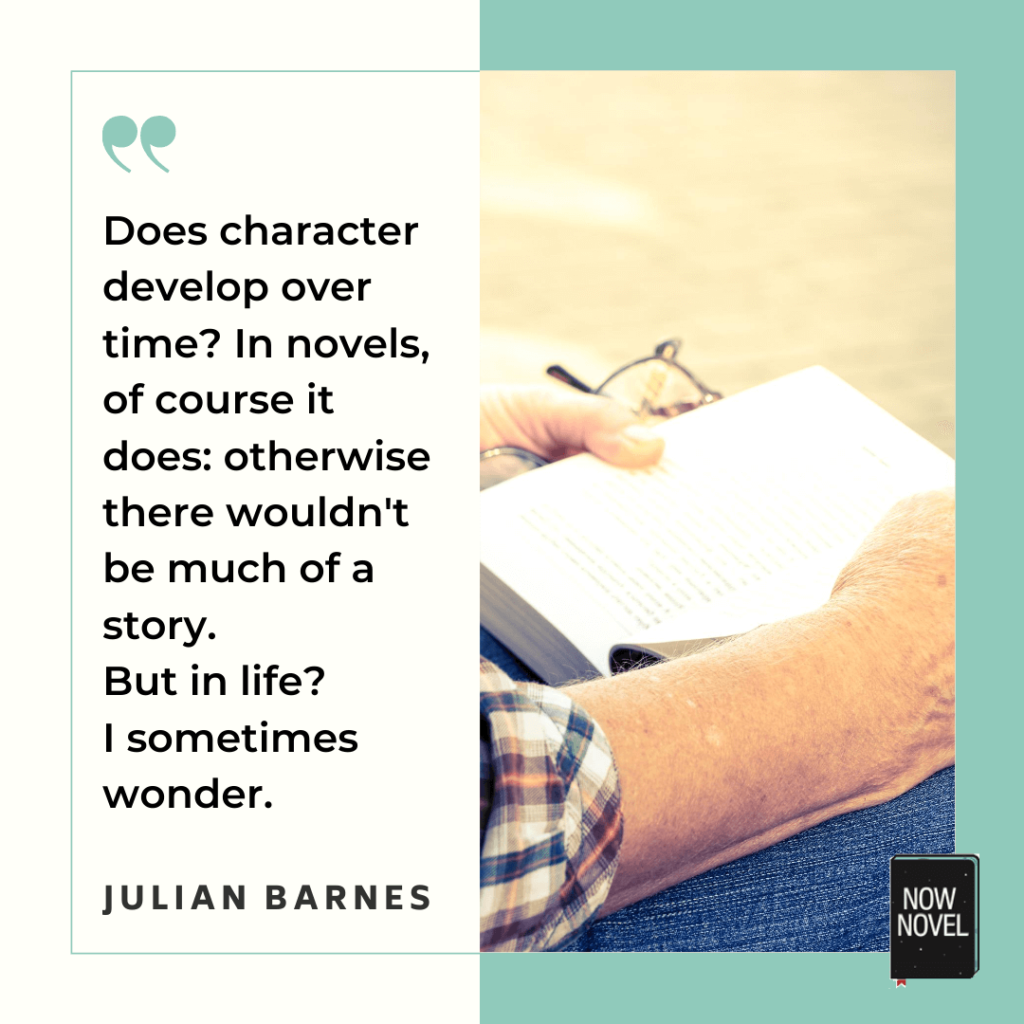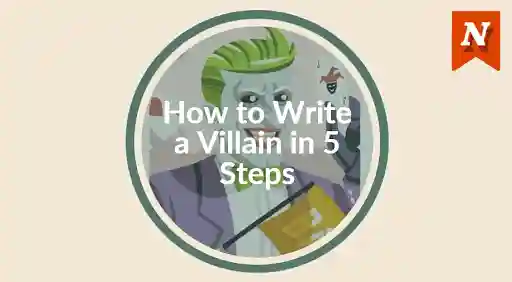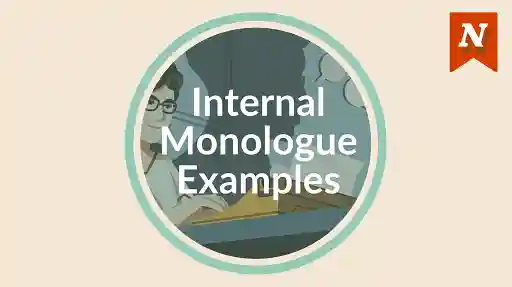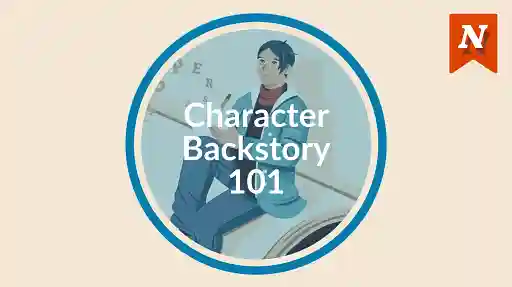In learning how to write character development, it's helpful to think about how each element of storytelling contributes. What are the basic facts about your character the reader should know, going in? What does dialogue do to develop your character further? Action? Narration? Description? Their desires and fears?
Read more on how to write character development, with examples from Michael Ondaatje's Anil's Ghost:
Character development lessons from Anil's Ghost:
- Brainstorm characters basics
- Use narrative exposition
- Use dialogue to develop character
- Develop characters via backstory
- Show actions and choices
- Describe desires and fears
Let's unpack these ideas, with examples:
1. Brainstorm character basics
Many authors begin character development before writing a single scene.
Brainstorming details about your character in advance of writing fully detailed scenes will help you find important details that shape how your character emerges. Details such as:
- Personality: Is your character meek, fiery, melancholic, or a combination of other things? Could these details shift over time, and if so, why?
- Backstory: What events in your character's past have shaped their present self?
- Fears and desires: What does your character long for, and what do they avoid?
- Psychology: What in their psyche is robust (for example, self-esteem) and what is fragile or vulnerable?
- Motives: What underlying factors drive the choices your characters make and what they want to do and achieve?
The 'Characters' section of the Now Novel dashboard is a useful tool for brainstorming these details and adding them to a structured outline. Try it for free when you finish reading.

2. Use narrative exposition
There's no development if we don't know where characters come from.
Being able to contrast your character's destination with their initial point of departure gives the reader a sense of the scope of your character's development - who they were to begin, and who they become.
Example of using exposition to develop a character
Take this example of narrative exposition. The description of a forensic anthropology site in Sri Lanka, in Michael Ondaatje's preface to Anil's Ghost, introduces the reader to Anil's occupation:
The families knew the approximate hours the scientists would arrive. They removed the sheeting and got closer to the submerged bones until they heard the whine of the four-wheel drive in the distance. One morning Anil found a naked footprint in the mud. Another day a petal.
Michael Ondaatje, Anil's Ghost (2000), p. 3.
From this, we already have a sense of Anil's work as a forensic anthropologist. By the end of the preface, we have a sense of Anil's empathy, after she sees a woman grieving over two dead bodies unearthed at the site and is haunted by this vision:
There are no words Anil knows that can describe, even just for herself, the woman's face. But the grief of love in that shoulder she will not forget, still remembers. The woman rose to her feet when she heard them approach and moved back, offering them room to work.
Ondaatje, p. 4.
By the end of the preface, a mere two pages, we know both Anil's occupation as well as the haunting impact it has on her due to the forensic nature of the work and how this encounters loss and grief.
This exposition gives Anil's character arc somewhere to go - we know her line of work, and some of the difficulties of the job.
3. Use dialogue to develop character
Once a character like Anil is introduced, we want to know more. About the situation (where is this forensic scene?) but also about who Anil is.
Dialogue gives an engaging way to develop characters. 'Voice' in dialogue may reveal many things:
- Elements of personality (e.g. assertiveness or submissiveness, kindness or cruelty)
- Inner conflict
- Background (e.g. cultural background in whether a person uses slang or formal speech)
On the second morning of the investigation Ondaatje first describes in his preface, we read dialogue that develops Anil further.
Example of using personality in dialogue to develop character
Anil has agreed to meet with forensic students to offer guidance:
She looked up at the young men. These were students who had not yet graduated, young enough to be appalled. It was the freshness of the body. It was still someone [...] She dipped each of the fingers in a beaker of blue solution so she could check for cuts and abrasions.
'About twenty years old. Dead twelve hours. Do you agree?'
Ondaatje, p. 14
'Yes.'
'Yes.'
They seemed nervous, even afraid.
'What are your names again?'
They told her.
'The important thing is to say out loud what your first impressions are. Then rethink them. Admit you can make mistakes.' (Should she be lecturing them?) 'If you are wrong the first time, redraw the picture. Maybe you can catch what was overlooked.... How did they break the arms without damaging the fingers? It's strange. Your hands go up to protect yourself. Usually the fingers get damaged.'
Ondaatje's dialogue develops Anil's character.
We sense Anil's sensitivity to others in her awareness the students seem afraid, and of the difference between their response to a dead body and her own. This detail also conveys that she is a seasoned professional who has some armour against the more unsettling aspects of the work.
Lastly, Ondaatje shows Anil's questioning, anthropologist's mind in her asking herself about her own method, whether she should be 'lecturing' the fearful students.

4. Develop characters via backstory
No discussion of how to develop characters would be complete without mentioning backstory.
Backstory allows the storyteller to move forwards and backwards in time at will.
Examples of using backstory in dialogue and narration to develop characters
In the early chapters of Anil's Ghost, interactions at the local Archaelogical Offices and hospital incorporate Anil's past, developing our knowledge of her further.
We know already she is an experienced, empathetic forensic worker. Ondaatje weaves in further backstory through Anil's interactions with others.
Example of using backstory in dialogue for character development
For example, when she meets one Mr. Sarath Diyasena:
As she entered the Archaeological Offices she heard his voice.
Ondaatje, p. 16.
'So - you are the swimmer!' A broad-chested man in his late forties was approaching her casually, with his hand out. She hoped this wasn't Mr. Sarah Diyasena, but it was.
'The swimming was a long time ago.'
'Still ... I may have seen you at Mount Lavinia.'
'How?'
'I went to school at St. Thomas's. Right there. Of course I'm a bit older than you are.'
'Mr. Diyasena ... let's not mention swimming again, okay? A lot of blood under the bridge since then.'
Here, Sarath Diyasena remembering a detail of Anil's past - that she used to be a swimmer - is used as a conversation point that shows Anil is not one for small talk or pretension. There's a sense of her abrupt, pragmatic nature in her one word answers ('How?') as well as her wish to not talk about her past.
This development is ambiguous and makes her character more interesting. We wonder whether there's something in her past she's avoiding discussing, whether she is wary of the man's overly-friendly approach, or if she's simply tired, curt, disinterested. The context alone (a campaign of political murders) gives Anil good reason to be wary.
Example of developing a character via narrated backstory
A page before Anil meets Sarath, we read other backstory - this time narration - that helps to contextualize Anil's purpose for being in Sri Lanka:
Suddenly Anil was glad to be back, the buried senses from childhood alive in her. The application she had made to the Centre for Human Rights in Geneva, when a call had gone out for a forensic anthropologist to go to Sri Lanka, had originally been halfhearted. She did not expect to be chosen, because she had been born on the island, even though she now travelled with a British passport. And it seemed somewhat unlikely that human rights specialists would be allowed in at all.
Ondaatje, pp. 15-16.
By this point in the story, Ondaatje has given us plenty of rich context for Anil's character. We know that Anil:
- Is a forensic anthropologist and human rights specialist
- Feels empathy for her subjects and those affected by their deaths (the grieving woman in the preface)
- Is experienced and has strong deductive skills (the scene with the students)
- Was born in Sri Lanka but now carries a British passport
- Was a swimmer
- Has an abrupt, curt manner (at least, with chummy older men or Mr Diyasena in particular)
5. Show actions and choices
What characters do and what they choose either whole-heartedly or reluctantly shows who they are.
How might a characters actions change over time?
In Anil's Ghost, initially, Anil seems reluctant to get involved with anything that could be a distraction from her investigative human rights mission.
As the story progresses, though, Ondaatje shows Anil being roped into engaging more, giving her more of herself to complex local entanglements.
Example of developing a character through their choices
For example, when a young man approaches Anil at Kynsey Road Hospital and asks her to give a talk:
A young man came up to her.
Ondaatje, p. 25.
'You are Anil Tissera, no?'
'That's right.'
'You won the scholarship to America.'
She didn't say anything. The foreign celebrity was being pursued.
'Can you give a small talk, thirty minutes, on poisoning and snakebite?'
They probably knew just as much about snakebite as she did, and she was sure that this choice of subject was intentional - to level the playing field between the foreign-trained and the locally trained.
'Yes, all right. When?'
Ondaatje shows Anil's uncertainty about being the 'pursued foreign celebrity', her tone suggesting a reluctance to be held up as a pinnacle of western learning or insight in her Sri Lankan island homeland.
This develops a further sense of Anil being pulled between her home roots, her experience away, and the loaded expectations and assumptions people project onto her as a result of this personal history.
The effect is we gain more context for understanding who Anil is. She is willing to share knowledge but is also aware of the social context in which knowledge is shared - who has power, who has a voice.

6. Describe desires and fears
No discussion of how to write character development would be complete without mentioning the cogs that make-up the clockwork of motives: desires and fears.
What we want and what we fear influence our paths through life immensely.
Knowing characters' desires tell us important things about what they value, and values may hint at many aspects of character such as:
- Past experiences that have shaped what matters to a person (for example upbringing, conditioning through experience)
- Ideology (what a person believes)
- Personality (whether a person is most at home in chaos or order, mess or organization, and so forth)
Example of developing a character through their desires
In a later section of Anil's Ghost, Anil is traveling with a teacher, Palipana, and Sarath, the man who asked about her swimming.
Anil asks if she can have bath when they stop near a well, saying 'We've been on the road since five this morning. Is that all right?'
Ondaatje reveals more about what Anil holds dear in describing the bath:
Once more she dropped the bucket into the well and jerked it up and poured it over her hair and shoulders so the water billowed within the thin cloth onto her belly and legs. She understood how wells could become sacred. They combined sparse necessity and luxury. She would give away every earring she owned for an hour by a well. She repeated the mantra of gestures again and again.
Ondaatje, p. 90
Here, Ondaatje creates a good sense of what Anil values and desires for herself, in a personal moment. The solitude, simplicity and ritual of the well bath and the 'luxury' of being able to cleanse oneself contrasts well with the dusty and 'dirty' work of forensic archaelogical digs.
Here Anil's desires make sense within the scene - the party has been driving since early morning. This small incident however also develops our understanding of Anil further, beyond the scene. It contrasts the relief in private moments of simple rituals, contrasting with the darker rituals of her professional life in digging up shadowy political killings and story-telling bones.
Develop more detailed characters as you work through our character description guide, or create detailed profiles and build an outline in the Now Novel dashboard.









